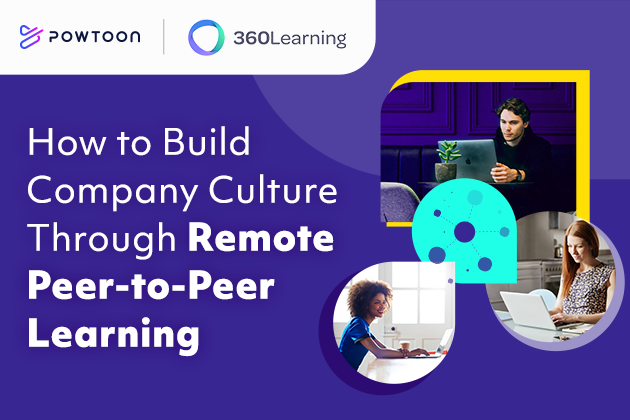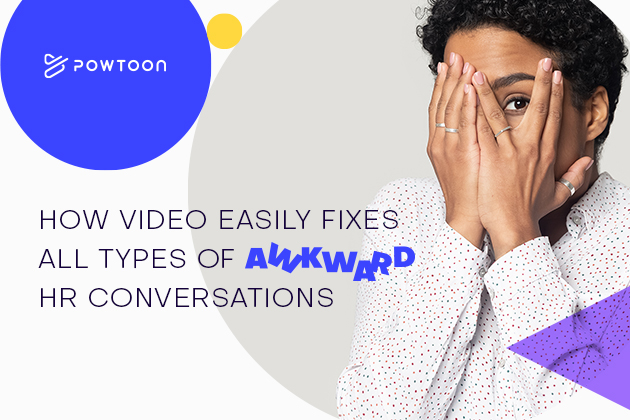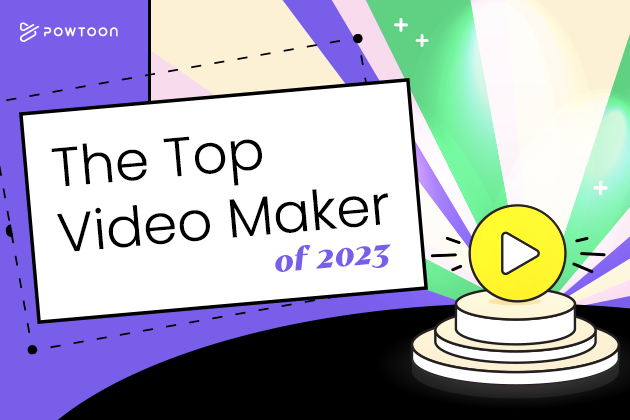
How to Build Company Culture Through Remote Peer-to-Peer Learning
According to research from Gallup conducted in September 2021, Forty-five percent of full-time U.S. employees worked from home either all (25%) or part of the time (20%). That’s a lot of working from home. And, although many employees are adamant that they’d like to retain this flexible work model in the future, some people do tend to feel lonely or even isolated in a remote work setting.
So, how can HR and L&D teams prevent workplace disengagement as work from home continues? One way of building up team spirit and company culture is through peer-to-peer learning, and it’s around this topic that speakers from 360Learning, Powtoon, and Drew’s Multimedia came together for a webinar on this very topic. Read on for the highlights.
How to leverage technology to share knowledge and stay connected in a remote workplace
In the office, you can saunter up to a colleague’s desk for a quick 1:1 meeting, call an impromptu brainstorming session, or bump into someone you haven’t seen in ages at the canteen. In a work-from-home setting, maintaining these relationships is a little trickier.
One of the tools employers have up their sleeve to keep connections alive is to lean into peer-to-peer learning: Many organizations are going this route because peer-to-peer learning:
1. Engages remote learners
By tapping into existing expertise, you not only provide hyper-relevant content to learners, but you engage the course creators as well. There’s also a notion of trust that gets established within a team when everyone is sharing and learning from each other, increasing that feeling of psychological safety that’s so central to a healthy remote culture. Finally, asking employees to share their knowledge shows you respect them, which can go a long way in building employee loyalty to the organization and improving remote productivity.
2. Helps stem the flood from The Great Resignation
77% of respondents in our study said they had knowledge to share in the workplace, but just hadn’t been asked to. They also shared that they want to learn more from their managers and peers. Building a peer-to-peer culture of learning answers those expectations, while also speeding up onboarding and retaining institutional knowledge within an organization, even after an employee leaves.
3. Is at the cutting edge of L&D
When it comes to course content, authentic is the new professional. It’s more impressive for learners today to get courses that are less ‘polished’ but are 100% contextual, instead of content with high production value but that lacks this authenticity. After all, we’re all used to seeing homemade content on YouTube and Google. Why shouldn’t we learn at work (or on the go, thanks to mobile learning) in the same style that we learn at home?
For all of these reasons and more, an L&D program based on peer-driven content is likely to engage learners, especially in a remote context, much more than traditional, top-down, or passive approaches to course creation.
If you have the right tools in place, it’s easy to empower your teams to create this kind of peer-to-peer content using a variety of media. Tools like Powtoon make it easy for anyone to whip up an animated explainer video (a flexible format great for outlining any complex topic), screen recording (a smart choice for software tutorials and similar), or video message (the classic face-to-camera style used by YouTube marketers).
How to use videos effectively to create better peer-driven learning experiences
But not all videos are created equal. To make sure your courses reach their full potential, here are some tips for creating engaging video content:
1. Do a “blue sky brainstorm”
Just like Disney execs, periodically run a brainstorming session where nothing is off-limits, and get out of your usual routine for coming up with video content ideas
2. Get buy-in.
If your higher-ups aren’t convinced about the merits of video (or a certain direction you’d like to take), be bold and use data and a trial run (testing your ideas on a small group of employees) to convince them.
3. Keep it short.
For better or worse, people’s attention spans are dwindling. Try to keep your content to five minutes or less.
4. Opt for voice-over.
Even though text on screen is a frequent solution, it can be hard to pace and often ends up being less intelligible than a nice voice-over. You don’t have to hire an actor, either—tap into the existing talent at your company!
5. Don’t try to do it all.
One video = one topic. If you’re too ambitious with what you want to cover, you’ll end up confusing your audience.
6. Launch where it makes sense.
Though it’s often a perfectly suitable option to launch your video on the company LMS or learning platform, certain videos might do just as well on the organization’s intranet.
7. Go for speed.
However you choose to create your videos, go for a tool that will enable you to get them out fast.
8. Use internal talent.
This is the backbone of peer-to-peer learning. Voice-over, content ideation, translation, brainstorming…Tap into your subject-matter experts to engage them in the learning process.
When it comes to creating video content or material in any format, keep in mind that embracing a Collaborative Learning approach will not only help you increase learner engagement, but save time on the production side, as well.
Collaborative Learning: Why a distributed, peer-to-peer learning approach strengthens company culture
In a traditional approach to creating Learning and Development courses, most of the movement is top-down: upper management, with the help of L&D, dictates course curriculum based on what they think employees need to learn. Then, the brunt of the course creation work lies within the L&D team, who often lean on SCORM courses or off-the-shelf content that’s generic and easily outdated. The whole process is slow and frustrating, and learners aren’t nearly as engaged as they could be.
With Collaborative Learning, it’s just the opposite: Employees declare their own Learning Needs, and internal subject-matter experts themselves create courses (with L&D teams as facilitators), that they can improve iteratively based on learner feedback. When a learning platform has a built-in authoring tool, content creation is light years faster, meaning it can remain fully contextual and up to date with much less effort. Because courses are based on institutional knowledge, constantly updated, and created using interactive learning techniques, learner engagement goes up.
The beauty of using this type of collaborative approach in a remote context is that it’s inherently cooperative and social; learners engage in interactions with their peers in discussion forums and by leaving reactions, and course creators interact with each other and with their learners through their instruction.
Imagine a remote onboarding experience for a new joiner that’s based on Collaborative Learning: New hires can immediately put faces to names, tag colleagues in comments with a question or feedback, and see their teammates in videos screen shares. Even if they’re joining from hundreds of miles away in a totally different time zone, they have much more opportunity to start connecting with the culture of their new workplace than with a traditional, siloed, and static approach to training.
Takeaway
Some degree of remote working is surely here to stay. While many see this as a huge advantage, there are some considerations that L&D and HR teams shouldn’t ignore; companies that don’t think about how they’re going to maintain their company culture remotely risk rising employee disengagement. A peer-to-peer approach to learning and development is one easily implementable strategy for maintaining cohesion among team members, remote or on-site.
Robin Nichols
Latest posts by Robin Nichols (see all)
- How to Build Company Culture Through Remote Peer-to-Peer Learning - December 7, 2021







